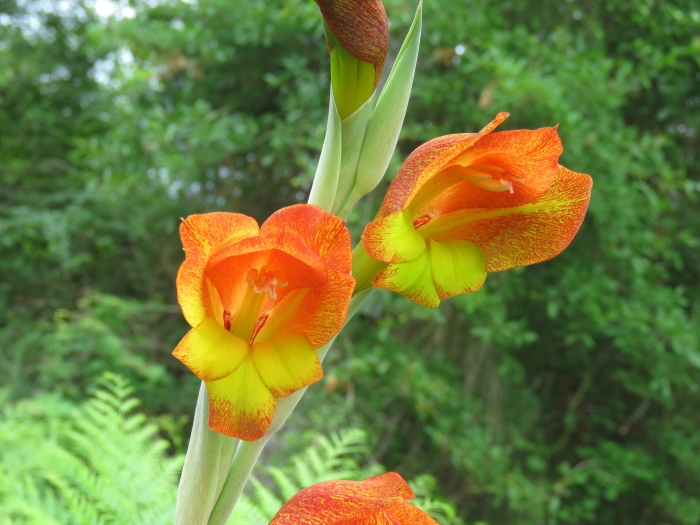African Gladiolus
(Gladiolus dalenii)
African Gladiolus (Gladiolus dalenii)
/
/

Laura Clark
CC BY 4.0
Image By:
Laura Clark
Recorded By:
Copyright:
CC BY 4.0
Copyright Notice:
Photo by: Laura Clark | License Type: CC BY 4.0 | License URL: http://creativecommons.org/licenses/by/4.0/ | Rights Holder: Laura Clark | Publisher: iNaturalist | Date Created: 2016-05-18T12:16:02-07:00 |


































































Estimated Native Range
Summary
Gladiolus dalenii, commonly known as African Gladiolus, is a deciduous perennial herb native to a variety of habitats including open woodlands, grasslands, and rocky slopes in Southern Africa. It can reach up to 4 feet in height and produces tall flower spikes with 5-7 large, showy flowers. The blooms range from yellow to scarlet, often with red streaks on a yellow background and a contrasting yellow throat, appearing in the summer months. The sword-shaped leaves add to its striking appearance.
African Gladiolus is valued for its vibrant, bicolored flowers that make excellent cut flowers and are attractive to pollinators. It is used in borders, cottage gardens, and as a focal point in floral arrangements. This plant thrives in light, sandy, well-drained soil with a neutral to slightly acidic pH (6.5-7), and it requires a sunny, sheltered position. While it needs high amounts of water during the growing season, it is drought-tolerant once established. It is not frost-hardy and in cooler climates, corms should be lifted and stored dry over winter. Potential problems include thrips, fungal diseases like rust, and corm rot if overwatered or in poorly drained soils. It is not typically invasive but can naturalize in suitable climates.CC BY-SA 4.0
African Gladiolus is valued for its vibrant, bicolored flowers that make excellent cut flowers and are attractive to pollinators. It is used in borders, cottage gardens, and as a focal point in floral arrangements. This plant thrives in light, sandy, well-drained soil with a neutral to slightly acidic pH (6.5-7), and it requires a sunny, sheltered position. While it needs high amounts of water during the growing season, it is drought-tolerant once established. It is not frost-hardy and in cooler climates, corms should be lifted and stored dry over winter. Potential problems include thrips, fungal diseases like rust, and corm rot if overwatered or in poorly drained soils. It is not typically invasive but can naturalize in suitable climates.CC BY-SA 4.0
Plant Description
- Plant Type: Herb
- Height: 2-4 feet
- Width: 1.5-2 feet
- Growth Rate: Moderate
- Flower Color: Yellow, Orange, Red
- Flowering Season: Summer, Fall
- Leaf Retention: Deciduous
Growth Requirements
- Sun: Full Sun
- Water: High
- Drainage: Fast, Medium
Common Uses
Bee Garden, Bird Garden, Butterfly Garden, Deer Resistant, Drought Tolerant, Hummingbird Garden, Potted Plant, Showy Flowers
Natural Habitat
Native to open woodlands, grasslands, and rocky slopes in Southern Africa
Other Names
Common Names: Cornflag, Maid-Of-The-Mist, Dragon’s-Head-Lily, Natal-Lily, Sword-Lily, Parrot-Lily
Scientific Names: , Gladiolus dalenii, Gladiolus psittacinus var. cooperi,
GBIF Accepted Name: Gladiolus dalenii Van Geel